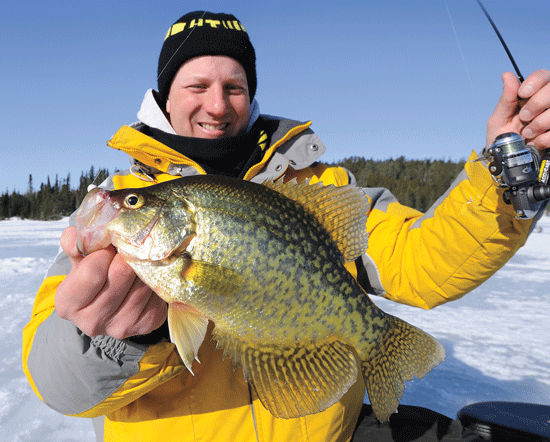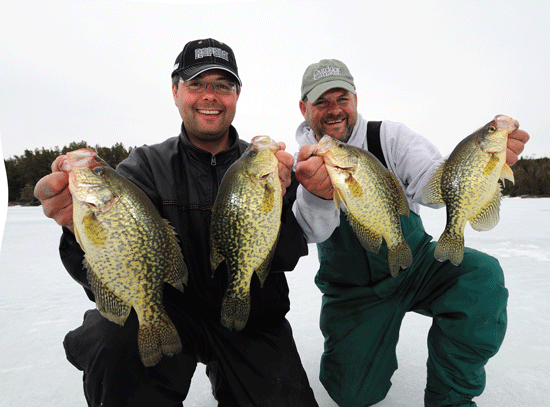
My best day ever for crappies is etched in memory, in part because it was an April Fool’s Day, now more than 30 years ago. Late in the season, after getting a blanket of wet snow, we augered holes over a deep basin, dropped transducers down holes, and the screens on our green Fish-Lo-K-Tors lit up like the Christmas tree in front of Macy’s Department Store. In 32 feet of water, crappies hovered in a giant pack, stretching across the middle of the water column.
I grabbed the first rod I could reach, one used the day before for speckled trout. It was spooled with 6-pound Maxima monofilament and the lure was a 2 1â„4-inch silver-plated Williams Wabler spoon weighing 1/4 ounce. Hardly standard crappie fare. I didn’t take time to tip the spoon.
Watching the fish react on sonar was a surprise. The spoon barely got below the ice before multiple crappies turned on the afterburner, screaming up out of the suspended assembly to intercept the fluttering mass of metal. The hits were crushingly hard. It was like dealing with aggressive lake trout.
I still have the grainy photo from that day hanging on my office wall. Back then everything that hit the ice stayed there. At the end of the day, I slid the slabs on a rope stringer and struggled to hoist it over my shoulder, the last crappie draping from the stringer touching the ice. The lesson from that day stayed with me for the rest of my ice fishing career.
At One Extreme
It always pays to consider one presentation extreme or the other. Generally, use much bigger and faster presentations when the fishing’s good—and use much smaller and slower presentations when the bite’s tough. That’s not much of a revelation in this age of ever-advancing ice information, but most crappie anglers still spend most of their time stuck somewhere in the middle of the presentation pack. They won’t consider beginning with a #3 Jigging Rap, but reach instantly for a minnow anchored by a split shot set below a float, or they reach for their standard small spoon.
On one end of the scale, I carry a whack of 1/7- and 1/4-ounce Williams Wabler spoons. I often use 1/16- and 1/8-ounce Northland Buck-Shot Rattle Spoons, and HT Hawger Spoons of the same size. The #2 and #3 Jigging Raps are standard fare for me, along with smallest Northland Puppet Minnow, the PM1. I have had many impressive catches with Raps and Puppets. Start the day with one of these aggressive lures—and many times you end it with one of the same aggressive presentations. I might add that I typically tip these lures with a small minnow head to begin, seeing if it’s necessary as the day advances. Often, especially with the Raps and Puppets, it isn’t necessary to tip.

If the fish aren’t getting after aggressive options you soon know it and can try something else—tinkering back a bit. But don’t be lulled into not considering the aggressive options again as the day continues. It’s typical to have hot fish for half an hour then have to go smaller and slower, especially during midday. Many days, though, as the sun settles the fish are once again all over an aggressive option, when they won’t touch tiny and slow.
Aggressive options are particularly productive during the first-ice period in December, when crappies are unpressured and hungry—and again at last ice in late March and early April, when their metabolism kicks back into high gear. During these peak periods you can “over finesse” fish. A tiny, trembling, micro-jig tipped with a maggot barely hovered near a crappie’s nose is ignored, while the same fish kick down the door and pummel a hunk of dancing metal.
The other rule here is no matter what lure eventually goes down the hole, to always consider pushing the window with what you might do with that lure. Don’t assume that the 1/16-ounce spoon has to be fished slowly—lift, drop, long pause. Dance it occasionally as it sinks to depth. Then once it settles, jiggle, jiggle, jiggle, barely pause. Repeat. The standard long pause often isn’t necessary. See how the fish respond.
Same with a micro jig like the Marmoska. Try some big dancing. Pound the jig hard, shaking your hand hard to get the jig to vibrate intensely. Often you barely have to reduce the pounding—or add the slightest pause—to get fish to eat. Again, the fish soon tell you what they want. But they can’t tell you they like the extreme end of the spectrum if you don’t try it.

The Other Extreme
The mighty mites at the other end of the scale excel when the bite’s tough, as it typically is during midwinter. This also often is the case when crappies are being pressured by legions of anglers. Even here, however, it still often pays to at least try aggressive maneuvers.
Still, during tough times, many anglers don’t scale down enough to interest crappies, nor slow down enough to finally trigger fish. I’ve written before about two of the best crappie anglers I know, Winnipeg, Manitobans Mike Schamber and Tom VanLeeuwen. Fishing in a crowd on Rainy Lake one day several winters ago I watched them catch and release more than 50 fish, while other anglers were blanking. Sensing how touchy the fish were, they experimented with progressively smaller jigs, finding that hair jigs weighing 1/60 ounce were part of the key. They didn’t need to be tipped but they had to be fished dead slow—almost deadsticked.
Absolutely dead slow often is a critical part of this end of this presentation picture. In-Fisherman Editor In Chief Doug Stange and I have had many fruitful days filming In-Fisherman Ice Fishing Guide television the last three years. We’ve demonstrated that at times you just can’t hold a rod still enough to trigger crappies.
Working with a spring bobber at the rod tip, the first step is to get a fish to come in—or move from hole to hole until you find one with a fish below it. Once a fish is within range, often the only way to get a bite is to prop the rod on the ice and watch the tip. At times, just barely touch the spring tip with a finger to tickle the jig below. Other times, don’t touch it at all for minutes on end. You know fish are hovering below because you can see them on electronics.
Eventually, the tip ghostly moves as the fish takes. On such days, this approach gets the job done to film a TV segment and eke out a meal of fresh fish.
To some it’s surprising that a fish, hovering in the dark, 30 feet beneath your boots can distinguish between 1/64-ounce difference in jig weight, or can detect just the right movement (or lack thereof) of a jig suspended below a rod setting dead still on the ice. But discriminate they can and often do. You see it time and again every winter if you watch for it.
Step away from the middle of the pack and spend time tinkering with presentations on the edge. You see things you haven’t seen before and have banner days the likes of which you’ve never experienced before.











































